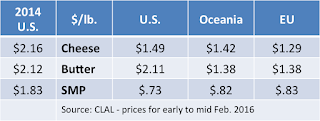The table below shows the 2014 prices compared to the current global prices for cheese, butter, and skimmed milk powder/nonfat dry milk.
In 2014, the wholesale price of cheese was $2.16/lb. as calculated by NASS. Today, U.S. cheese is worth $1.49/lb. and European cheese is worth $1.29/lb. Skimmed milk powder/nonfat dry milk was worth $1.83/lb. in 2014, and today it is worth $.73/lb. in the U.S. and slightly more in other parts of the world. That is less than half the price of a year ago. U.S. Butter has retained amazing price resilience maintaining a price point equal to 2014 and significantly above international prices.
These changes are driven by many factors. which will be covered below. Today, it is cheaper to buy butter internationally than to buy butter churned domestically. These commodities plus dry sweet whey are used to price producer milk. The factors driving these lower prices globally are as follows:
- Russia's ban of dairy products has hit EU dairy producers and processors very hard. Prior to August 2014, approximately 1/3 of of EU cheese was exported to Russia. Note above, that EU cheese is now very low priced in order to move volume. Because of the strong USD, U.S. cheese is expensive, and EU cheese is taking market from the U.S. in Japan and in the U.S. Butter is facing a similar fate as nearly 40% of EU butter was exported to Russia prior to the ban. Butter inventories in the E.U. are very high and export prices are very low. The Russian ban will last through August of 2016. What will happen then is unknown. For at least most of 2016, this situation will keep E.U. dairy products low priced while they try to find a home for this excess production.
- China is importing less Whole Milk Powder (WMP) and therefore New Zealand is shifting this excess milk to cheese manufacturing, again putting pressure on global cheese stocks. Here again, the U.S. is being hurt by the strong USD. New Zealand is expected to reduce herd sizes and reduce some of this excess milk, primarily reducing cheese production. Also, because China is importing less WMP, the EU is shifting to more Skim Milk Powder and butter, increasing global availability of these products.
- In all of the above, the strong USD is making U.S. exports difficult.
A review of the major export categories follows. Cheese will be reviewed first as the pricing of cheese is the most important input to the Class III milk formulas.
Cheese exports are down 14% in 2015 after five years of significant growth. Cheese imports are also up significantly in 2015
As a result, the net cheese exports (exports-imports) are down considerably in 2015. As a result, U.S. stocks of cheese are reaching high levels as reviewed in the prior post, and with high inventories, prices fall for cheese and, by formula, for Class III milk.
How have U.S. cheese exports changed? Below is a graph comparing 2014 and 2015 exports.
Mexico is the only significant growth country for cheese exports. Further growth in cheese exports to Mexico is expected in 2016. As mentioned above, lower prices from the EU and New Zealand have taken market from Korea and Japan.
On the import side, imports to the U.S. from the EU and New Zealand have increased, reducing net exports and increasing stocks of cheese in the U.S.
U.S. domestic consumption, the other part of the total cheese "disappearance" analysis will be reviewed in the next post to this blog.
U.S. butter pricing has followed a very unusual path. As noted in the table above, U.S. butter prices are well above competitive butter prices. As a result, there are almost no exports. Butter priced well above butter from the EU and New Zealand will not sell. Also, churning production is down and there are no available stocks to export.
However, to reach U.S. consumption levels, butter must be imported. (See more on U.S. consumption trends in the next post.) And, with lower international prices, imports have escalated to levels not seen in 10 years.
As a result, the U.S. has become a net butter importer. As long as the huge difference in prices between the U.S. ($2.11/lb.) and international prices ($1.38/lb.), the trend toward more imports will continue. U.S. butter prices will fall in 2016.
Who is providing the butter that is imported into the U.S.? It's quite a mixture; Ireland, New Zealand, Mexico, France, etc.
Nonfat Dry Milk/Skim Milk Powder (NDM/SMP) has had an amazing 2015, at least in terms of volume. In spite of huge international pressures, NDM/SMP has stayed at nearly constant export volumes over the last three years. In fact, 2015 was a new record for exports of NDM/SMP. Unfortunately, pricing was way off, down 60% from 2014.
Surprisingly, imports were also up,
This left the balance on net exports down slightly from prior years.
Mexico is importing NDM/SMP and reconstituting it for distribution to low-income families. In Mexico, low-income families represent a huge market. These exports of NDM/SMP to Mexico are expected to maintain the current volumes in 2016. Sales of NDM/SMP to other countries are very small and may present a volume opportunity in 2016 if low pricing in maintained.
Exports of dry whey were down 22% for 2015, with most of the fall occurring in the second half of the year. As a result dry whey exports accounted for only 40% of dry whey production in 2015 vs. 58% in 2014.
In summary, exports have all been under great pressure for the reasons mentioned above. Little change is expected in 2016. In the next post, 2015 dynamics of the domestic U.S. dairy market will be reviewed.

















No comments:
Post a Comment